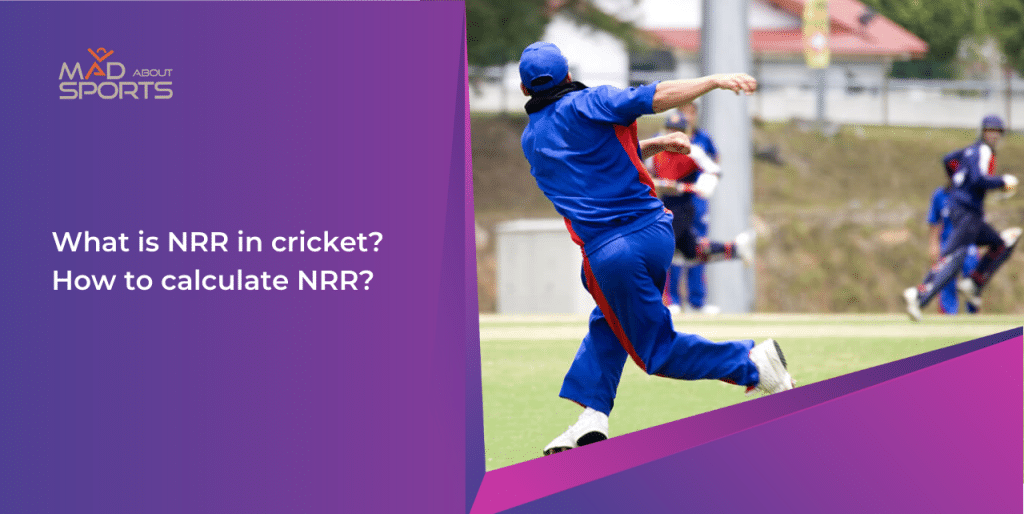In cricket, the Net Run Rate (NRR) is an important measure used to evaluate a team’s performance and ranking in limited-overs formats. NRR serves as a tiebreaker when teams have equal points and provides an overview of their scoring efficiency and bowling effectiveness.
Understanding NRR helps cricket enthusiasts grasp its role in determining team success and rankings.
This article explores the concept of NRR, how it is calculated!
Table of Contents
What is NRR?
Net Run Rate is a method adapted frequently in cricket that serves as a tie-breaker in multi-team tournaments. It is often misunderstood but is very easy to understand.
What is the formula to calculate NRR?
Net Run Rate is calculated using this simple formula:
Net Run Rate (NRR) = Run rate for the team – Run rate against the team
where,
Run rate for the team = Total runs scored by the team in the tournament / Total overs played by the team in the tournament
Run rate against the team = Total runs conceded by the team in the tournament / Total overs bowled by the team in the tournament
If a team bowls a total of 50.1 overs in a tournament, then it should be considered as 50.17. Similarly, if the number of overs bowled is not in whole numbers then given below is how we will take the number of overs bowled into consideration which is significant to three decimal places. You can similarly count it up to as many decimal places as you wish to:
Converting balls into overs: Number of balls bowled / 6
For example,
1 ball: 0.167
2 balls: 0.333
3 balls: 0.500
4 balls: 0.667
5 balls: 0.833
6 balls: 1.000
Calculating NRR – Practical Example
To better understand this topic, we will provide a worked-out example of NRR calculation based on the points table shown below that represents the standings of the Super Four stage of Asia Cup 2022:
| Team | Matches | Won | Lost | Tied | NR | Points | NRR |
|---|---|---|---|---|---|---|---|
| Sri Lanka | 3 | 3 | 0 | 0 | 0 | 6 | +0.701 |
| Pakistan | 3 | 2 | 1 | 0 | 0 | 4 | -0.279 |
| India | 3 | 1 | 2 | 0 | 0 | 2 | +1.607 |
| Afghanistan | 3 | 0 | 3 | 0 | 0 | 0 | -2.006 |
Let us calculate India’s NRR in this tournament.
Given below are the details of the runs scored and conceded by India in every game of the Super Four stage of the tournament:
Match 1:
IND 181/7 (20)
PAK 182/5 (19.5)
Match 2:
IND 173/8 (20)
SL 174/4 (19.5)
Match 3:
IND 212/2 (20)
AFG 111/8 (20)
As we can see from the above, India made a total of 566 runs in 60 overs.
Run rate for India = 566/60 = 9.433
We can also see from above that India conceded a total of 467 runs in 59.4 overs.
Converting 59.4 overs according to numbers given in previous section: 59.4 overs = 59.667
Run rate against the team = 467/59.667 = 7.826
NRR = 9.433 – 7.826 = 1.607
You can match this NRR with the table given above and see our calculation of NRR matches with the table.
Conclusion
A team that has scored runs effectively and/or successfully slowed down the opposition’s scoring rate will typically have a greater positive NRR. A team that has a lower or negative NRR, on the other hand, is thought to have either struggled to score runs at a good rate or to have given up runs frequently.
Teams with a higher NRR typically have an edge in tiebreaker circumstances in tournaments. The team with the greater NRR is often positioned ahead in the standings if two or more teams have an equal number of points. It is important to remember that tournament rules might change and that there might be other tiebreakers in place besides NRR, such as head-to-head outcomes or total victories.
The interpretation of NRR will ultimately depend on the specific tournament regulations and the context in which it is applied. In order to assess a team’s overall performance and position in a cricket competition, it is crucial to take into account the whole set of tiebreaker criteria as well as other elements pertaining to the rules of the particular tournament.

